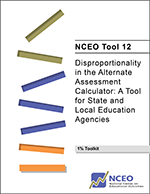Students who do not have the most significant cognitive disabilities may sometimes be inappropriately assigned to participate in the alternate assessment based on alternate academic achievement standards (AA-AAAS). There is concern that a disproportionate percentage of students from some racial and ethnic subgroups may be over-identified as having a most significant cognitive disability and inappropriately assigned to this assessment. Assessment participation decisions have major implications for a child’s future. A short-term implication is that the child’s instruction may be less rigorous and they will not have access to some important content that other students get. Longer-term implications are that the child may not be able to receive a regular diploma, and post-secondary and career options may be limited.
The federal government requires states that have over one percent of students participating in alternate assessments to submit plans or waiver requests for how they will address being over the one percent threshold. One required component of these plans or waiver requests is that the state must indicate how they will address any disproportionality in alternate assessment participation. Figuring out whether there is disproportionality in alternate assessment participation is the first step that states and their districts need to take.
To address this need, NCEO has developed a disproportionality calculator tool. The new resource Disproportionality in the Alternate Assessment Calculator: A Tool for State and Local Education Agencies (NCEO Tool #12) is part of the 1% toolkit. This resource contains a tool that State and Local Education Agencies (SEAs and LEAs) can use to examine disproportionality with respect to student group participation in their AA-AAAS. Examining disproportionality with regard to alternate assessment participation is essentially an inquiry into whether certain groups are over- or under-identified as having a most significant cognitive disability. Participation data for groups of interest (e.g., race/ethnicity, economically disadvantaged, English learner status, chronic absenteeism) can be entered for a SEA or LEA. The tool then calculates the risk ratio, which is a way to describe the relationship between observed versus expected proportions.

